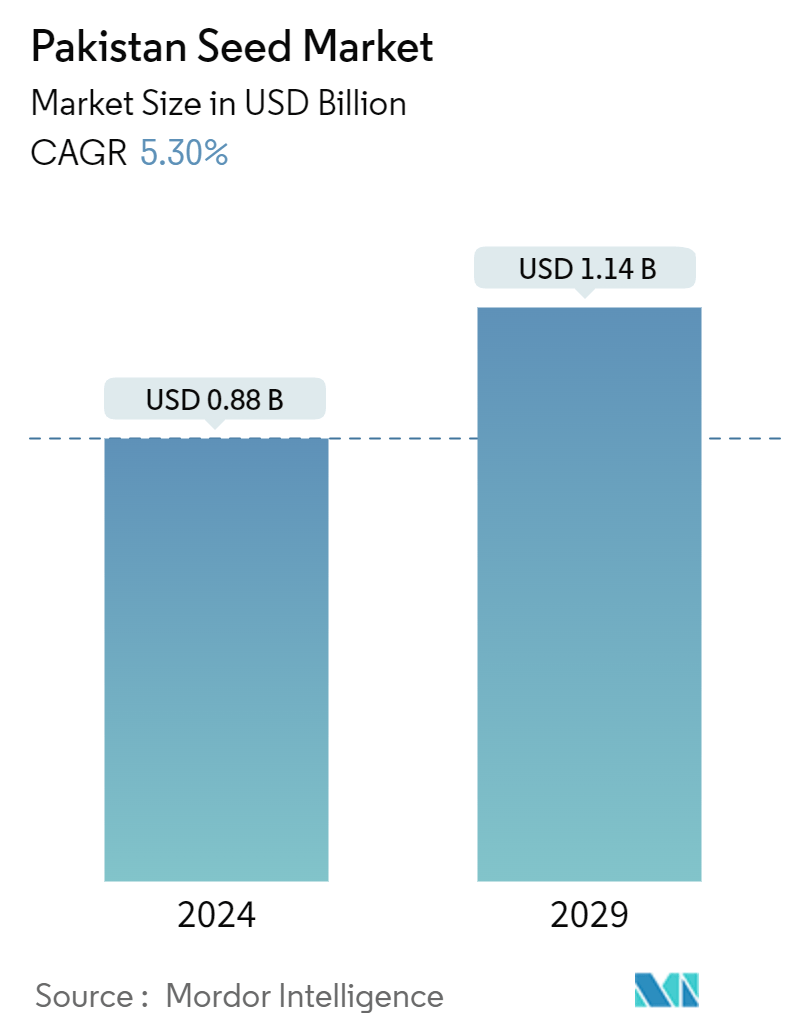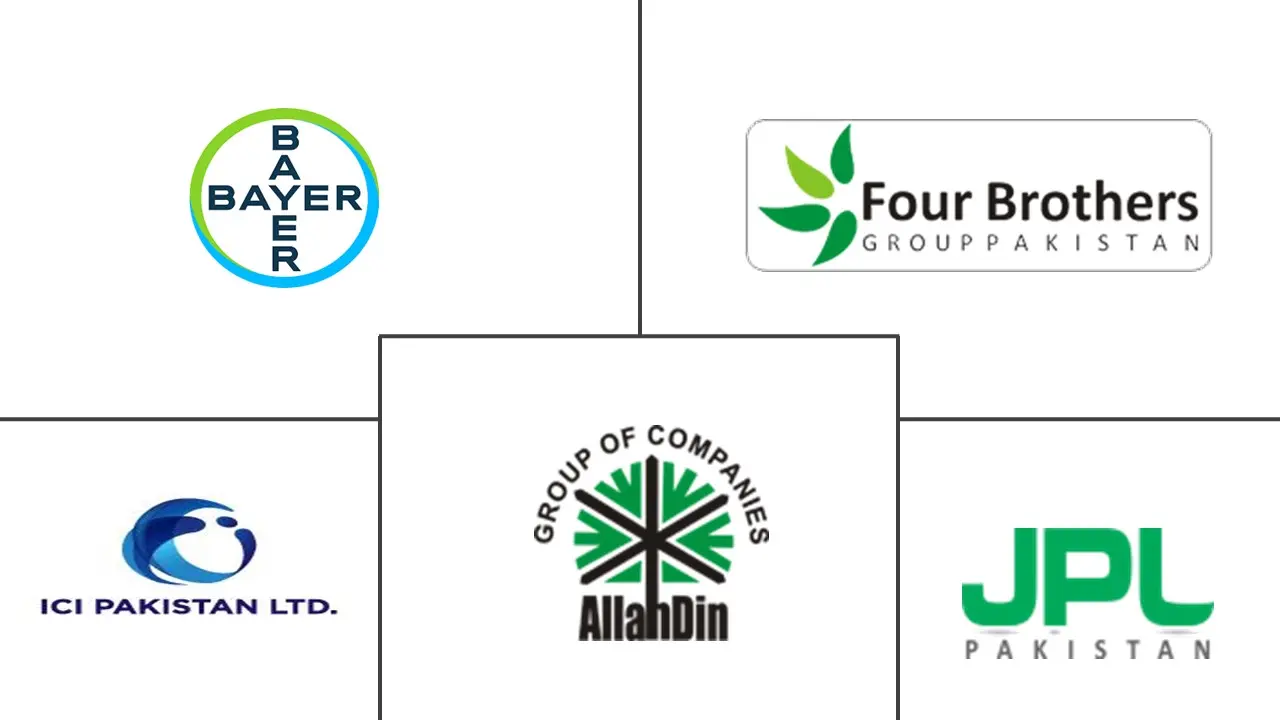Market Size of Pakistan Seed Industry

| Study Period | 2019 - 2029 |
| Base Year For Estimation | 2023 |
| Market Size (2024) | USD 0.88 Billion |
| Market Size (2029) | USD 1.14 Billion |
| CAGR (2024 - 2029) | 5.30 % |
| Market Concentration | Low |
Major Players
*Disclaimer: Major Players sorted in no particular order |
Pakistan Seed Market Analysis
The Pakistan Seed Market size is estimated at USD 0.88 billion in 2024, and is expected to reach USD 1.14 billion by 2029, growing at a CAGR of 5.30% during the forecast period (2024-2029).
- An increase in hybrid seed penetration is anticipated in multiple crops to address the rising food demand-supply mismatch in the country. Due to a decrease in arable land and a constant increase in population, the per capita arable land has declined. These factors, along with poor crop productivity, are likely to create pressure on the food supply in the country.
- The seed sector in Pakistan is characterized by agitation between archaic regulations and entrepreneurs in the growing market. All critical aspects of the system, such as licensing of seed producers, variety release procedures, access to public germplasm, quality control, intellectual property rights (IPRs), imports, and exports, are all governed by laws and rules framed several decades ago for a system dominated by public-sector enterprises. However, seed law amendments and the introduction of new laws to propagate biotech seeds can be promising steps toward formalizing the informal sector.
- In Pakistan, hybrid seed penetration is the highest in cotton. Hybridization in corn, paddy, and vegetables is increasingly gaining momentum and is estimated to drive the sector growth during the forecast period.
- Pakistan is a member of the World Trade Organisation (WTO) and is obligated to provide a mechanism to protect plant varieties. Pakistan is also a member of the International Treaty on Plant Genetic Resources for Food and Agriculture, which recognizes the right of farmers to save, use, exchange, and sell farm-saved seeds. Accordingly, Pakistan adopted the Plant Breeders' Rights Act to encourage the development of new plant varieties and protect the rights of breeders of such types, thus attracting local and foreign investment in research, technology, and development, in the seed industry. The act also respects the right of farmers to save, use, exchange, and sell farm-saved seeds, a practice that is the backbone of the agricultural system and the main channel through which farmers access sources in most developing countries.
Pakistan Seed Industry Segmentation
A Seed is the small hard part of a plant from which a new plant of the same kind can grow. The study includes commercial seeds for sowing for various crop categories, including grains and cereals, vegetables, and oilseeds. The Pakistan Seed Market is segmented by Product Type (Transgenic, Non-transgenic, and Open Pollinated) and Crop Type (Grains and Cereals, Oilseeds, Vegetables, and Other Seeds). The report offers market sizing and forecasts in value (USD Thousand) for all the above segments.
| Product Type | |
| Transgenic | |
| Non-transgenic | |
| Open Pollinated |
| Crop Type | |||||||
| |||||||
| |||||||
| |||||||
| Other Seeds |
Pakistan Seed Market Size Summary
The seed industry in Pakistan is poised for growth, driven by the increasing adoption of hybrid seeds across various crops to meet the rising food demand amid a declining per capita arable land. The sector is navigating through a landscape of outdated regulations that govern critical aspects such as seed production licensing, variety release, and quality control. However, recent amendments and the introduction of new laws aimed at promoting biotech seeds are expected to formalize the informal sector and attract investment. The industry is characterized by a mix of local and international players, with companies like Bayer Crop Science Pakistan and ICI Pakistan leading efforts in product innovation and market expansion. The government's initiatives, including financial packages and support for high-quality seed production, further bolster the sector's growth prospects.
The market dynamics are influenced by the need for increased agricultural productivity due to land degradation and population growth. This has led to a shift from conventional seed sources to high-yielding varieties, encouraging practices like contract farming to maintain produce uniformity. The introduction of new open-pollinated and hybrid varieties, such as those from the Maize and Millets Research Institute, supports diverse cropping systems and reduces reliance on imports. Despite the challenges, the trend towards home vegetable production and the availability of open-pollinated seeds are contributing to market expansion. The seed industry in Pakistan is expected to continue its growth trajectory, supported by regulatory reforms, technological advancements, and strategic investments.
Pakistan Seed Market Size - Table of Contents
-
1. MARKET DYNAMICS
-
1.1 Market Overview
-
1.2 Market Drivers
-
1.3 Market Restraints
-
1.4 Porter's Five Forces Analysis
-
1.4.1 Threat of New Entrants
-
1.4.2 Bargaining Power of Buyers
-
1.4.3 Bargaining Power of Suppliers
-
1.4.4 Threat of Substitute Products
-
1.4.5 Intensity of Competitive Rivalry
-
-
-
2. MARKET SEGMENTATION
-
2.1 Product Type
-
2.1.1 Transgenic
-
2.1.2 Non-transgenic
-
2.1.3 Open Pollinated
-
-
2.2 Crop Type
-
2.2.1 Grains and Cereals
-
2.2.1.1 Rice
-
2.2.1.2 Wheat
-
2.2.1.3 Corn
-
2.2.1.4 Other Grains and Cereals
-
-
2.2.2 Oilseeds
-
2.2.2.1 Cotton
-
2.2.2.2 Sunflower
-
2.2.2.3 Rapeseed
-
2.2.2.4 Other Oilseeds
-
-
2.2.3 Vegetables
-
2.2.3.1 Solanaceae
-
2.2.3.2 Cucurbit
-
2.2.3.3 Roots and Bulbs
-
2.2.3.4 Brassica
-
2.2.3.5 Other Vegetables
-
-
2.2.4 Other Seeds
-
-
Pakistan Seed Market Size FAQs
How big is the Pakistan Seed Market?
The Pakistan Seed Market size is expected to reach USD 0.88 billion in 2024 and grow at a CAGR of 5.30% to reach USD 1.14 billion by 2029.
What is the current Pakistan Seed Market size?
In 2024, the Pakistan Seed Market size is expected to reach USD 0.88 billion.

